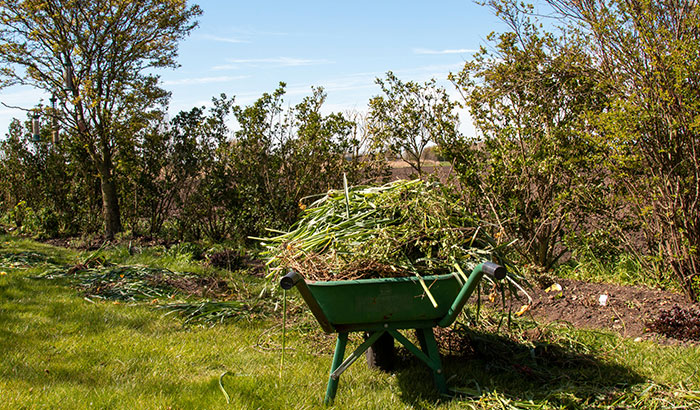Weeding your lawn is an absolute necessity if you want your yard to be presentable. After all, that “greatest lawn” award isn’t going to win itself!
If you’ve had a hard time keeping the weeds at bay, you may wonder how it’s even possible to keep your yard pristine. Luckily, there are a few simple things you can start doing now that will help you maintain your yard.
Here are nine tips for weeding your lawn.
1. Dig Weeds up by the Root
Many plants are hardy, but few are as hardy as weeds can be.
To effectively remove weeds, it is important to pull them up by the root. If you leave the root in the ground, it can easily regrow, and the weed will bounce back quickly. Pulling the weed up by the root ensures that the entire plant is removed, reducing the chance of it returning.
To do this, grab the weed close to the base and gently pull upward, making sure to get as much of the root as possible. If the root is long or deep, you may need to use a garden tool to loosen the soil before pulling.
If you are using a garden tool, use it to loosen the dirt directly around the root of the weed. This will make it easier to pull the roots out of the ground.
This may take some extra effort, but it is worth it to have a clean, weed-free garden.
2. Weed Often
A trick to keeping unwanted plants at bay is to weed them out often.
Weeding often is a key component in maintaining a healthy and weed-free garden. One of the main reasons why weeds are difficult to control is that people wait until they are too big to be easily removed. If you take the time to weed early, when the weeds are still small, you will have an easier time controlling them.
This is because smaller weeds are easier to pull out by the root and have not had a chance to spread their seeds and multiply. By weeding regularly, you can prevent the buildup of weeds in your garden and keep them under control. This requires consistent effort, but it is necessary for a lush and thriving garden.
3. Use a Scuffle Hoe or Regular Hoe
A scuffle hoe or regular hoe can be an effective tool for removing large patches of weeds in yards, gardens, and planter boxes.
These tools work by slicing the weeds off at the base, cutting the root, and making it difficult for them to regrow. They are especially useful in areas that are covered in weeds and make quick work of tasks that would otherwise be time-consuming.
Although using a scuffle hoe or regular hoe can be labor-intensive, they are effective at removing large patches of weeds in a short amount of time.
4. Remove Weed Debris
Cleaning up weed debris is an important step in the process of maintaining a weed-free garden. If you leave the uprooted plants lying in your garden, they can reestablish their roots back into the soil and regrow. To prevent this from happening, it is important to clear up the debris after weeding.
This can be done by either removing the weeds from your garden or mulching them back into the soil. By doing so, you prevent the weeds from continuing to grow and ensure that your garden remains free of unwanted plants.
Clearing up weed debris not only helps to keep your garden looking neat and tidy but also helps to prevent the return of weeds, making your gardening efforts more effective in the long term.
5. Dethatch Your Lawn Every Once-in-A-while
Dethatching your lawn can help prevent weed growth by removing the layer of dead grass, leaves, and other organic material that accumulates on top of the soil. This layer, known as thatch, can prevent air, water, and nutrients from reaching the roots of your grass, making it more susceptible to weed growth.
Dethatching your lawn helps to remove this layer, promoting the healthy growth of your grass and reducing the chance of weed seeds from taking root. This can be done using a thatching rake or by hiring a professional lawn care service.
By regularly dethatching your lawn, you can keep it healthy and weed-free, creating a lush and attractive outdoor space.
6. Avoid Allowing Seeds To Spread
Some weeds have the ability to produce hundreds of seeds with every flowering head, which makes controlling them even more challenging. Once these plants reach maturity, they can release their seeds, spreading them throughout your lawn and compounding the amount of work you need to do to keep it in pristine condition.
In order to control the spread of these weeds, it is important to catch them early and remove them before they have a chance to flower and release their seeds. This may involve regular monitoring of your lawn and frequent weeding, but it is worth it to keep it healthy and weed-free.
7. Repatch With Lawn Seed if Necessary
Removing a large weed from your lawn can sometimes result in a patchy appearance, particularly if the weed is taking up a significant amount of space. This can happen because the removal of the weed can disrupt the growth of the surrounding grass, leaving bare spots in your lawn.
To restore the appearance of your lawn, you may need to reseed the patchy areas. This involves spreading grass seed over the bare spots and then covering it with a layer of soil. You will also need to water the area regularly to encourage the grass to grow.
Reseeding patchy areas of your lawn can be time-consuming, but it is worth it to restore the health and appearance of your lawn. By reseeding, you can help to create a lush and well-maintained lawn that is free of weeds.
8. Use Specific Weed Killers
Chemicals can be used to control weeds in your lawn, but they should be used sparingly and only after you have exhausted every other practical option.
Some chemicals can damage your lawn as they kill weeds, and they can also leave lingering chemicals in your lawn that can continue to cause harm. When using chemicals, it is important to be deliberate about how you use them and to choose a product that is specifically designed for use on lawns.
Some weed killers are formulated to target large leafy plants, which can help to protect your grass. As a general rule, it is best to use chemicals only as a last resort and to rely on other methods, such as manual weeding, whenever possible.
9. Burn Your Lawn
As a last resort, you may consider burning your lawn to get rid of weeds, but this should only be done if a large portion of your yard is dominated by weeds and other methods have been exhausted.
Keep in mind that burning can eliminate important vitamins and nutrients that plants need to grow, so it is important to fertilize your yard extensively before reseeding or resodding. It is important to follow all local fire regulations and to take necessary precautions to prevent the spread of fire.
Before attempting to burn your lawn, it may be a good idea to consult with a professional landscaper or local authorities to ensure that it is safe and feasible to do so. Burning your lawn should be seen as a last resort and should only be done if you are experienced and knowledgeable about the process and the potential risks involved.
Get High-Quality Sod From Monarch Sod
Are you in need of a high-quality lawn and don’t know where to start? Get quality sod from Monarch Sod! We provide quality grass to homes and businesses all over the Salt Lake, Utah Valley, and Ogden areas.
After all, before you weed your yard, you need a yard to weed.
Contact us today to get your own high-quality sod.
toto slot










